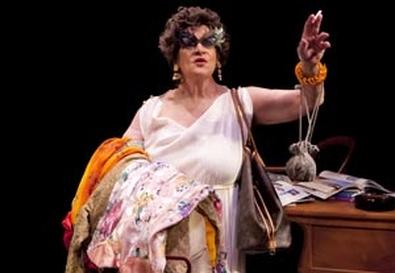
Judy Rosenblatt likes and admires Peggy Guggenheim more than I do. We know this because Rosenblatt is giving an intense and committed performance as the 20th-century art patron (1898–1979) in a self-produced one-woman show. Guggenheim certainly provides a part to chew on, and chew on it Rosenblatt does. Yet, while the heiress deserves great credit for appreciating, acquiring, and underwriting modern art from the 1920s through the 1950s, she left something to be desired as a person.
By most accounts, including this one, Guggenheim was a bad wife (twice), an erratic mother, an even more distant grandmother, a petty and argumentative employer, and an inconstant and perhaps insatiable lover in and out of her marriages, with a particular penchant for gondoliers. She referred to her collected paintings as her "children" and was buried next to the beloved dogs she was always afraid would be kidnapped for ransom. One of her real offspring committed suicide after several tries, and the other was a wastrel who lived off his mother's largess. All of this is made clear in the 95-minute piece, written by Lanie Robertson, who is best known for "Lady Day at Emerson's Bar and Grill," about Billie Holiday, a much more sympathetic character despite her many flaws and problems.
Rosenblatt makes a couple of missteps in her portrayal. Her curly black fright wig is constantly distracting at such close range. In her program acknowledgements, Rosenblatt credits no fewer than eight friends who helped her learn her lines. At least one of them, or director Austin Pendleton, should have pointed out to her that the esteemed clothing designer Elsa Schiaparelli's last name was pronounced "Skiaparelli," not "Shapparelly," and that Venice's luxe hotel Cipriani is pronounced "Chipriani," not "Sipriani." These are errors an international sophisticate like Guggenheim would not have made.
Despite these flaws, Rosenblatt is largely convincing and Pendleton's blocking is nimble enough, given the four distinct scenes to be played in a confined space. But Robertson has attempted much more than this production can deliver. His play is set from 1963 to 1968, when Guggenheim had stopped acquiring paintings and was fretting over which museum would inherit her collection, valued at $40 million at 1966 prices. The first three scenes are in the garden, bedroom, and library of her palazzo in Venice, and the final scene is in a gondola on the Grand Canal. This self-described "triptych in four parts" would be hard enough to pull off on a large stage. Despite good work here by set and sound designer Giovanni Villari and lighting designer Stephen Petrilli, it's all too cramped to be credible.
The first and fourth scenes work well enough, but the second is largely a one-sided expositional conversation with Guggenheim's offstage daughter, telling us things the daughter would long know by heart. (Also, why in a $20 million palazzo are the two women sharing a bathroom?) The third segment is also one-sided: a much interrupted telephone conversation with the director of the Tate Gallery. Worst of all, we never get to see the one thing we can all agree was Guggenheim's lasting contribution to the culture: her painting collection. Even though the character keeps promising to show us her treasures "later." Please give us video, slides, prints, bad copies—anything to depict the Braques, Picassos, Ernsts, Pollocks, and other artworks Guggenheim had the foresight to buy ahead of their time. This serious staging omission leaves the production literally artless.
Presented by Judy Rosenblatt at the Abingdon Theatre Arts Complex, 312 W. 36th St., NYC. May 17–29. Tue.–Sat., 8 p.m.; Sun., 2 p.m. (212) 352-3101 or www.spincyclenyc.com.